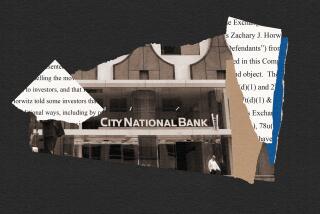Deposit Insurance System Was Culprit in S&L; Mess
- Share via
Where was the press when the savings and loan industry got into its current mess? A financial press that prides itself on its hard-nosed, investigative journalism did little to bring the deteriorating condition of the industry to light. Washington is crowded with reporters. Yet, when their opportunity came, the financial press mishandled it.
For years, economists have pointed to the flaws in the deposit insurance system that encourages S&L; managers to take high risks when their equity position is low. As S&L; failures developed, these alarm bells were ringing more and more frequently. Conferences and books developed the theme. Members of Congress, the press and the regulators participated at many of these conferences. Still, little was done to bring the problem to public attention or to correct it.
By the mid-1980s, some economists at the regulatory agencies produced regular estimates of the growing magnitude of the losses. By 1985, many S&Ls; had sustained losses so large that they were technically insolvent. One economist, Edward Kane, coined the term “zombie S&Ls;” for the associations that, though insolvent, were kept in business by the regulators and ignored by Congress and the financial press.
Even now, the press contributes to congressional efforts to obscure the causes of the failure. Congressional investigations seem designed to convince the public that the massive losses imposed on the public came about because of the corrupt, criminal or unethical behavior of some slick operators.
The slick operators were part of the problem, but a small part. A careful study of the losses by Alexandria, Va., thrift consultant Bert Ely, an expert on the industry, found that fraud was responsible for losses of $5 billion out of the nearly $150-billion cost to the taxpayers. Add $3 billion for losses on junk bonds and another $3 billion for losses on non-real estate investments. These losses together are about 7% of the total cost. And, some of the losses on junk bonds and non-real estate investments are the result of honest mistakes, choices that can be criticized only with hindsight.
Ely’s estimate may be off the mark. Suppose the losses from bad judgment, fraud and chicanery are 10% of the total. Add another $5 billion for Ely’s estimate of the excess cost of the hasty 1988 sales of S&Ls; that some in Congress are investigating diligently. More than 81% of the losses have other causes. Why are they ignored?
I am not opposed to congressional investigation of fraud. Far from it. It is important to know why, how and by whom the public was defrauded. The Justice Department is also investigating these cases and properly so.
My objection is that by focusing exclusively on the 7% to 10%, Congress ignores the bulk of the problem and does nothing to avoid a repetition. The press contributes by giving the public the impression that Congress is hard at work learning who is to blame, avoiding a repetition and developing a safe and sound financial system.
The unreported story is a tale of administrative failure, regulatory failure, failure of congressional oversight and, most of all, flawed institutions. The arrangements, designed to protect the public from the consequences of bank failures, didn’t work as intended. True, the banks and S&Ls; didn’t shut their doors, wiping out the depositors’ accounts. But that is not much consolation to the average taxpayer who will pay about $1,500 for his or her share of the losses.
Deposit insurance began as a program to protect small savers against bank runs--attempts by depositors to get their money out before a bank failed. When deposit insurance began in the 1930s, insurance was limited to $2,500 per depositor. In today’s depreciated dollars that would be about $25,000, an amount far above the amount held by most depositors.
Over time, the limits were raised. By the mid-1980s, accounts were insured to $100,000. And when banks or S&Ls; were about to fail, regulators would usually protect all depositors without any limit at all. For large banks, the doctrine became “too big to fail.” Everyone was assured that the government or regulators would not allow a big bank to fail, no matter how unwise or risky its lending practices. This policy encouraged risk taking and, ultimately, large losses.
Of course, the regulators examined and supervised banks on a regular basis. As we know from successive rounds of defaults on Latin American debt, real estate loans, energy loans and loans for leveraged buyouts, supervision and examination are weak reeds on which to rest the safety and soundness of the financial system.
Something is rotten in our system. If we look north to Canada, east to Europe or west to Japan, we do not find anything comparable to our experience. Few of these banking systems have experienced problems of failure and costly bailouts by taxpayers. These countries, too, have endured oil shocks, rapid disinflation, real estate booms and the like. But so far only U.S. taxpayers have ended up bailing out large parts of the financial system.
Real financial reform will not come until large depositors have an incentive to monitor what their banks do, just as they monitor the credit worthiness of other parties who owe them money. It would be difficult and costly for small depositors to do the same. They could be protected by offering them the option of keeping their deposits in accounts that are completely secured by Treasury bills--direct obligations of the federal government. Such accounts are available now at some money market mutual funds.
The Treasury Department will present a plan for deposit insurance reform this winter. Early rumblings from the Treasury suggest that their proposals for change will be modest, little different than current practice. They seem likely to keep deposit insurance as it is and promote better supervision, more capital and more careful examination. This would be more of the same--a repeat of the past mistakes that helped to produce the current failures.
Congressional elections are coming this fall, before the Treasury’s report. Candidates will probably repeat the stories about fraud, chicanery and mischief. And, they’ll promise to punish wrongdoers. But they won’t talk about major reform to prevent a repetition or explain why the U.S. financial system--regulated and insured for decades--has been so costly to taxpayers and depositors and so prone to failure compared to systems in other countries.
The public would be more likely to question the candidates if the press would inform them about the facts of the case. Stories of fraud and personal failure may make good copy but that’s only 10% of the story. The other 90% needs to be heard and fixed also.
More to Read
Inside the business of entertainment
The Wide Shot brings you news, analysis and insights on everything from streaming wars to production — and what it all means for the future.
You may occasionally receive promotional content from the Los Angeles Times.










